Haworthias are perennial succulents native to Africa. They come in different varieties, and they are recognized by their rosette shape, solitary columns in layers, compact leaves, and green color. Some varieties have long foliage with white stripes and dots.
In general, Haworthia requires bright indirect sunlight, average watering, well-drained soil, standard temperature ranging between 65-75°F, periodic fertilization, average humidity, repotting every 2-3 years, and protection from cold drafts and air currents.
If you seek the correct care tips for Haworthia, you are at the right place. I will share all the care tips you need to gain in-depth knowledge. By following them, you can avoid making mistakes and keep the plant healthy for a long time.
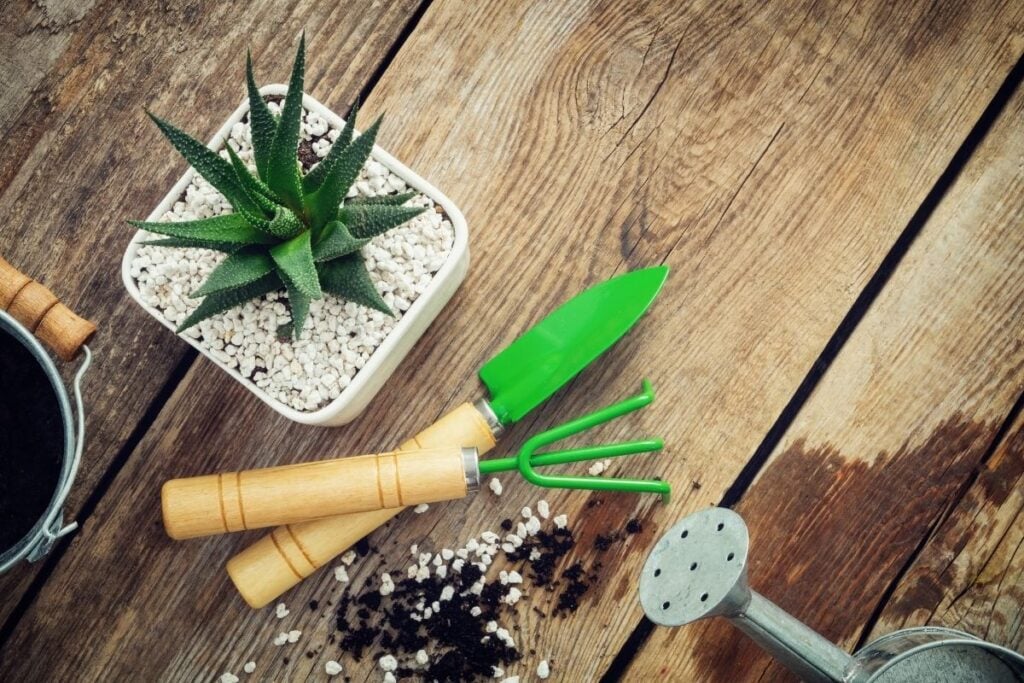
14 care tips for Haworthia
Haworthias are easy to grow and require less attention.
But still, you need to give attention to certain care tips to fulfill their requirement and keep them healthy.
Read the 14 essential care tips for your Haworthia.
1. Plant Haworthia in the spring.
Haworthias grow best when planted in the spring because it is the growing season.
But, if you do it in some other month, like during the summer or winter, you might not see them grow.
Firstly, they remain dormant in the summers and grow slowly in winter.
On top of that, Haworthia is a slow-growing succulent.
Haworthia will also grow actively during the fall, but I suggest planting them in spring.
Spring has a cool but warm temperature that boosts the plant’s growth.
Moreover, they come out very slowly from their summer dormancy in the fall and take a lot of time to start growing.
They might slow down slightly, but they don’t stop growing in winter.
Once spring arrives, Haworthia will continue its growth at a little faster pace.
Also read: How Fast Do Haworthia Grow? (Average Growth Rate)
2. Plant Haworthia away from direct sunlight.
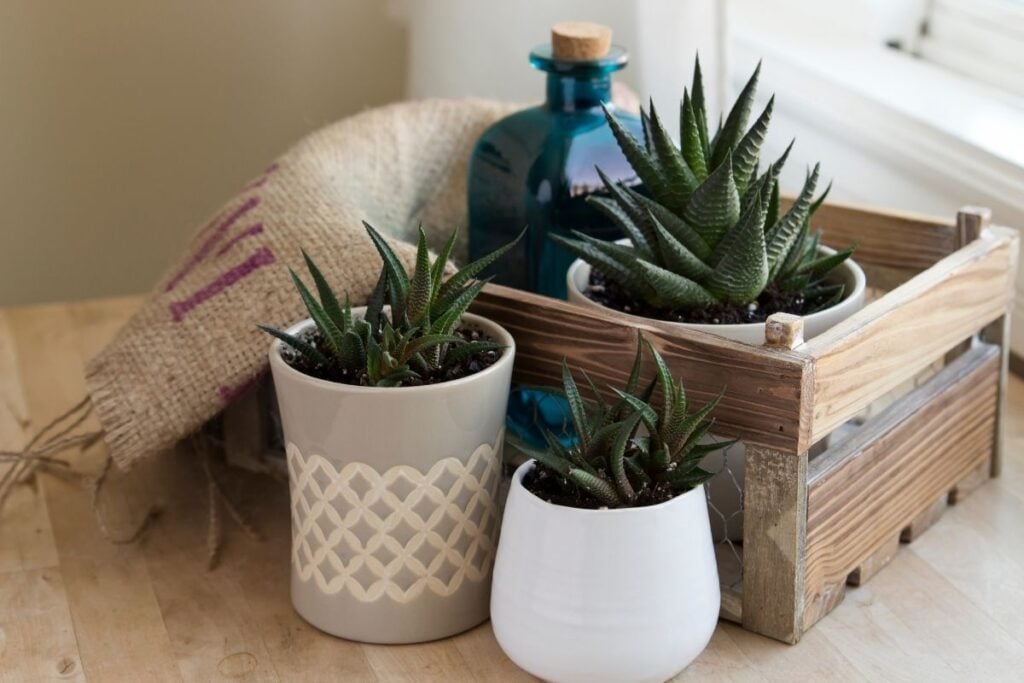
An ideal location for Haworthia is a zone with ideal light and some trees around.
Look out for a direction in your garden that gets an ample amount of sunlight.
A north or east direction is fine.
These two directions get mild sunlight that won’t harm the Haworthias.
Moreover, unlike other directions, the sunlight will start getting less intense and fade in these two directions as the day progresses.
The second thing you need to look for to choose the right location is the surrounding area.
The area should neither be too open nor covered with tall trees, walls, or buildings.
They can block the sunlight from reaching the garden bed.
Additionally, the trees can drip water over the Haworthias, and increase their humidity, thus rotting them.
If the area is too open, the plant will receive direct sunlight at some point in the day.
The plant will also get direct air currents which will affect their health and result in brown leaf tips.
There must be tall trees but at an adequate distance so that the garden bed gets indirect sunlight.
The tall trees and parapet walls can block the sudden air currents.
Also read: How Much Light Does Haworthia Need? (Haworthia Light Requirements)
3. You can grow Haworthia both indoors and outdoors.
Since Haworthias demand low light, less watering, and average temperature, they are ideal indoors.
But that doesn’t mean they can’t be grown outdoors.
Haworthias will adapt to indoor and outdoor environments if supplied with adequate requirements.
Though they can be grown in containers, you can plant them directly in the ground.
Most people keep them in containers because they are small and look pretty in planters.
Also read: Is Haworthia An Indoor Plant? (Indoor Care+Can We Keep It Outside)
Looking for gardening supplies? We have tested 100's of products before recommending them to you guys. Check out our best pick below:
| Image | Gardening Supplies | Best Price? |
|---|---|---|
 Top
Top Top
Top | Raised Garden Bed Kit | Check On Amazon |
 | XLUX Soil Moisture Meter, Plant Water Monitor, Soil Hygrometer Sensor for Gardening, Farming, Indoor and Outdoor Plants, No Batteries Required | No Results |
 Top
Top Top
Top | 82 Pcs Garden Tools Set and Extra Succulent Tools Set | Check On Amazon |
 | Joeys Garden Expandable Garden Hose with 8 Function Hose Nozzle, Lightweight Anti-Kink Flexible Garden Hoses, Extra Strength Fabric with Double Latex Core, (50 FT, Black) | No Results |
 Top
Top Top
Top | Dual Chamber Compost Tumbler | Check On Amazon |
 Top
Top Top
Top | Sunnyglade Plant Stakes | Check On Amazon |
 Top
Top Top
Top | Organic Cold Pressed Neem Seed Oil | Check On Amazon |
 Top
Top Top
Top | Mighty Mint Gallon :-Insect and Pest Control Peppermint Oil | Check On Amazon |
 Top
Top Top
Top | Scotts DiseaseEx Lawn Fungicide | Check On Amazon |
 Top
Top Top
Top | Jacks Classic 20-20-20 All Purpose Fertilizer | Check On Amazon |
 Top
Top Top
Top | 30,000 Seeds Pollinator Attracting Wildflower Mixture | Check On Amazon |
 Top
Top Top
Top | Survival Vegetable Seeds Garden Kit-Over 16,000 Seeds | Check On Amazon |
4. Haworthias must receive an ample amount of bright indirect sunlight.
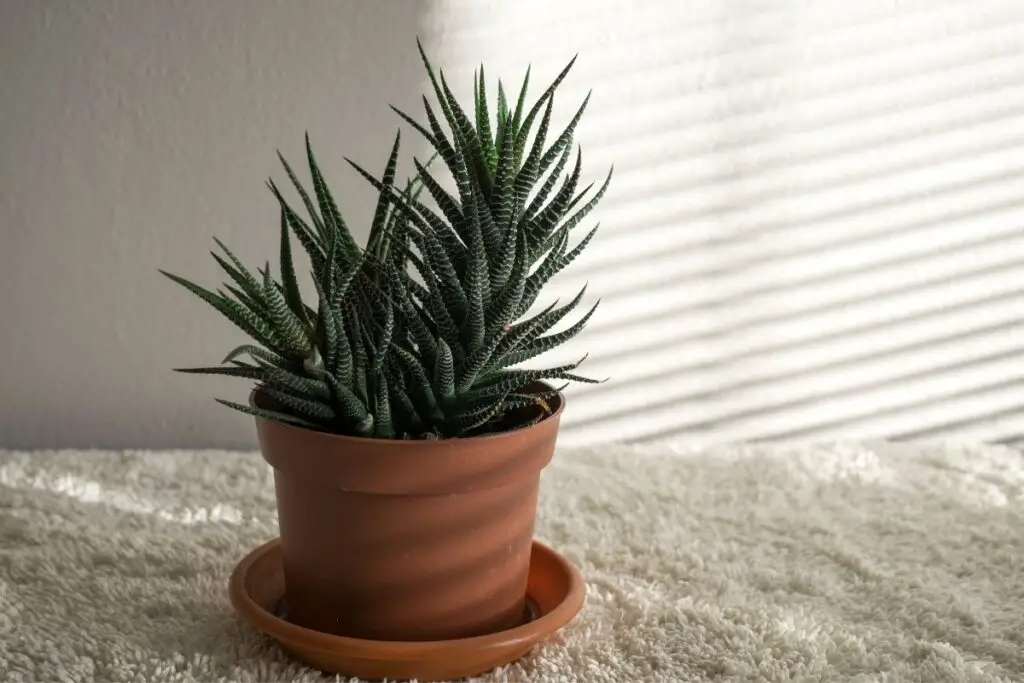
Haworthias must get an adequate amount of sunlight all day.
Though they will thrive in filtered sunlight, 3-5 hours of direct sun in the morning will keep them healthy.
You have to find out the ideal location for them.
If the Haworthias get direct sun, shade them with shading nets.
Open it in the morning for a few hours, and then put it on when the sun gets harsh.
If you have a location that receives perfect light conditions, you can plant your Haworthia there without further analysis.
Here, you might not have to put extra effort into arranging shading cloths or nets.
In the case of indoor Haworthias, keep them near an east-facing window without curtains.
For south or west-facing window, put on sheer curtains to filter the light.
Also, shift the plant some feet back when the sunlight gets intense.
Also read: Is Haworthia A Cactus?
5. Water your Haworthia when the top 1-3 inches of the soil gets dry.
If you are a beginner, you must first check the soil’s moisture and then water the Haworthias.
By this, you will excel at understanding the plant’s watering needs eventually.
You will understand the time the growing medium takes to dry out and make a schedule accordingly.
In general, Haworthias need water every 2-3 weeks.
It may differ depending on the weather, soil type, plant size, maturity, and the container you use.
You can water Haworthias every 1-2 weeks when they grow rapidly in the spring.
You can water once a month in the winter as the water takes time to dry due to less evaporation.
Summer is their dormancy period, but watering keeps their roots cool.
So in the summer, you must check the soil moisture and then water.
Also read: How Often To Water Haworthia? (Haworthia Water Requirements)
6. Plant Haworthias in well-drained soil with a pH level of 6.6 to 7.5.
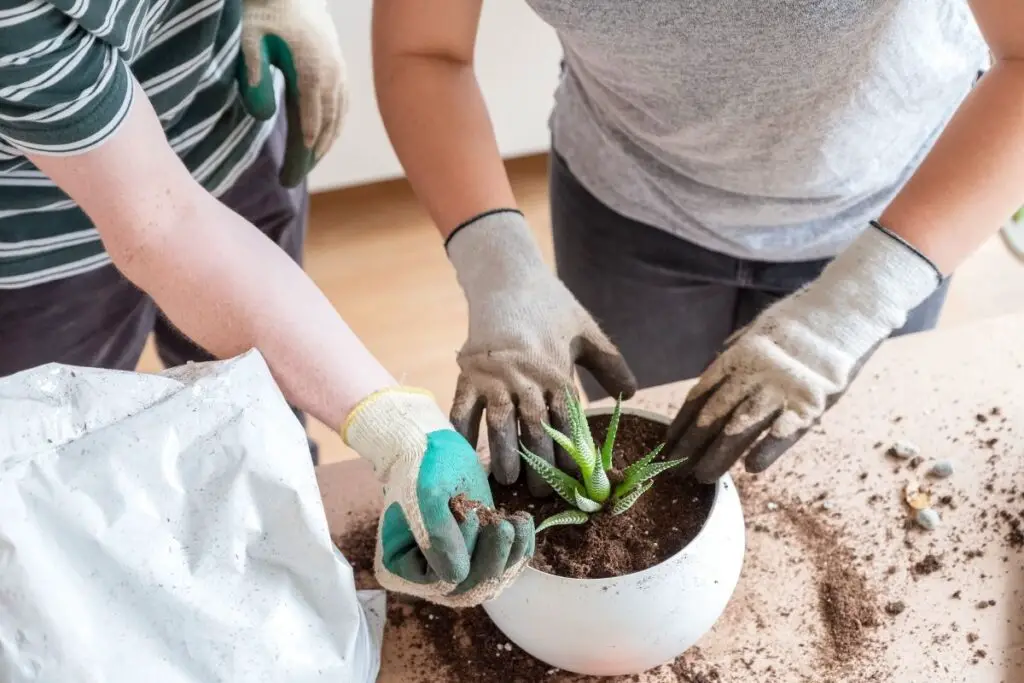
Haworthias must be planted in well-drained soil with the ideal pH level.
The best kind of soil should have a balance of drainage and retention.
The plant will then neither suffer overwatering nor underwatering.
If the soil doesn’t drain water well, the roots will stay wet for a long time and start rotting.
On the other hand, if the soil dries out too fast, the plant will suffer underwatering.
Some ideal soil mixes are:
Recipe 1
Recipe 2
Equal parts of:
- 60% Coarse sand
- 40% Potting soil.
Recipe 3
- 50% gravel of appropriate size
- 50% of soil, coarse sand, and organic fertilizer
Recipe 4
- 80% pumice
- 20% coir, 1-3 mm approx.
Recipe 5
- 40% parts potting soil
- 40% parts small gravel
- 20% part perlite or pumice
If you grow Haworthia in containers and don’t want to make a soil mix, use the cactus potting mix as they contain perlite and pumice, which are great porous ingredients to help in drainage.
Also read: What Soil To Use For Haworthia? (+Ideal Soil Mix)
7. Fertilize Haworthias only once during the spring and fall.
Haworthias grow actively during the spring and fall.
Though Haworthias won’t mind if you don’t fertilize them, feeding can boost their growth rate.
Haworthias are slow-growing succulents and take a lot of time to come out of their resting period.
Fertilizing also helps the plant come out of its dormancy a little faster.
It will also help them recover from any growth issues.
Also read: How To Fertilize Haworthia? (Best Fertilizer+When To Use)
8. Haworthias require warm temperature and normal humidity levels.
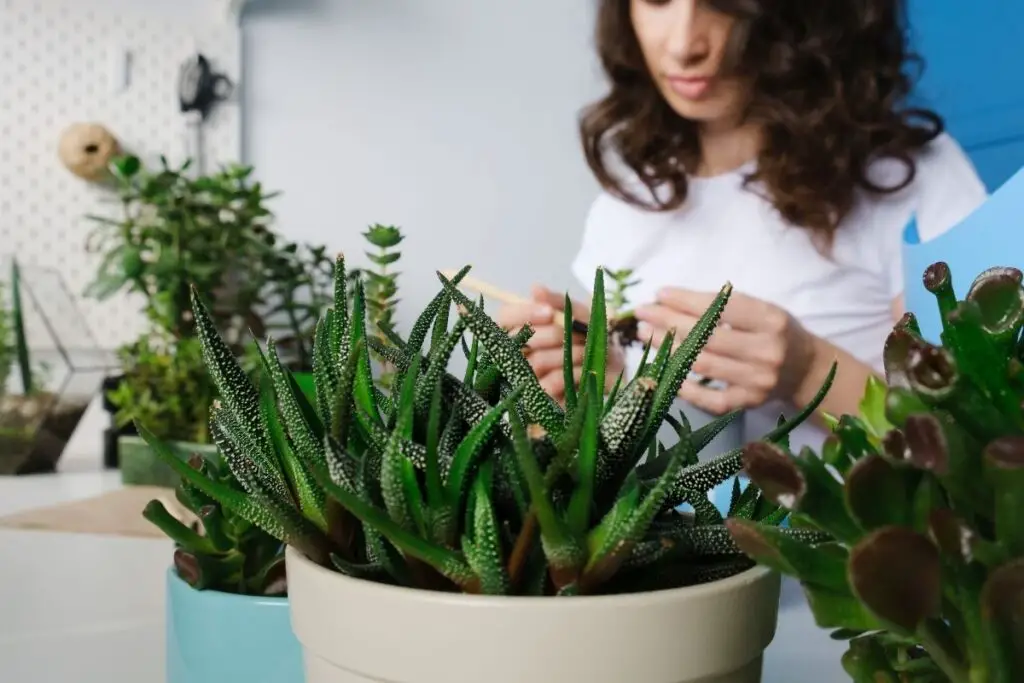
Haworthias grow well when they get a warm temperature ranging between 65 and 75°F.
Their maximum temperature tolerance is 80 to 90°F, and the minimum is 30 to 45°F.
In the summers, Haworthia will tolerate 77 to 90°F in the day and 57 to 68°F at night.
If the temperature rises above 90°F at night, they will go dormant.
However, protect the plant outdoors from the direct scorching sun.
When the temperature drops below 30°F, they will require protection from cold and snowfall.
They are tender succulents and are sensitive to cold.
You must bring them indoors at such temperatures.
Otherwise, they will get frostbite.
Haworthias don’t require very high humidity.
An average level ranging between 25 to 40% is good for them.
A little high humidity can make them fleshy, but too much high can rot them.
Also read: Do Haworthia Like Humidity? (Misting & More)
9. You must protect Haworthias from the low temperature in the winters.

As mentioned in the previous point, Haworthias cannot endure low temperatures.
Haworthias can tolerate cool winters.
They will tolerate 57-78°F in the day and 39-50°F at night.
Once the temperature drops below 30°F, you must take them indoors.
Otherwise, the plant cells will burst at such low temperatures, and the foliage will have damp black marks, indicating frostbite.
If your region gets snowfall in the winters and temperature drops below 30°F, grow Haworthias in containers so that you can take them indoors in the winters.
Don’t bother them with watering or fertilizing.
Check the soil’s moisture level and then water when the top 2-3 inches get dry.
Indoors, keep them some feet back from the windows.
Choose a room that is slightly warm for Haworthias in winters.
Please don’t keep them in an air-conditioned room during hot or usual temperature days.
Besides, don’t keep them near heaters or radiators during the winters.
Also read: Haworthia Temperature Tolerance: High And Low Temperature Guide
10. Repot Haworthias every 2 to 3 years.
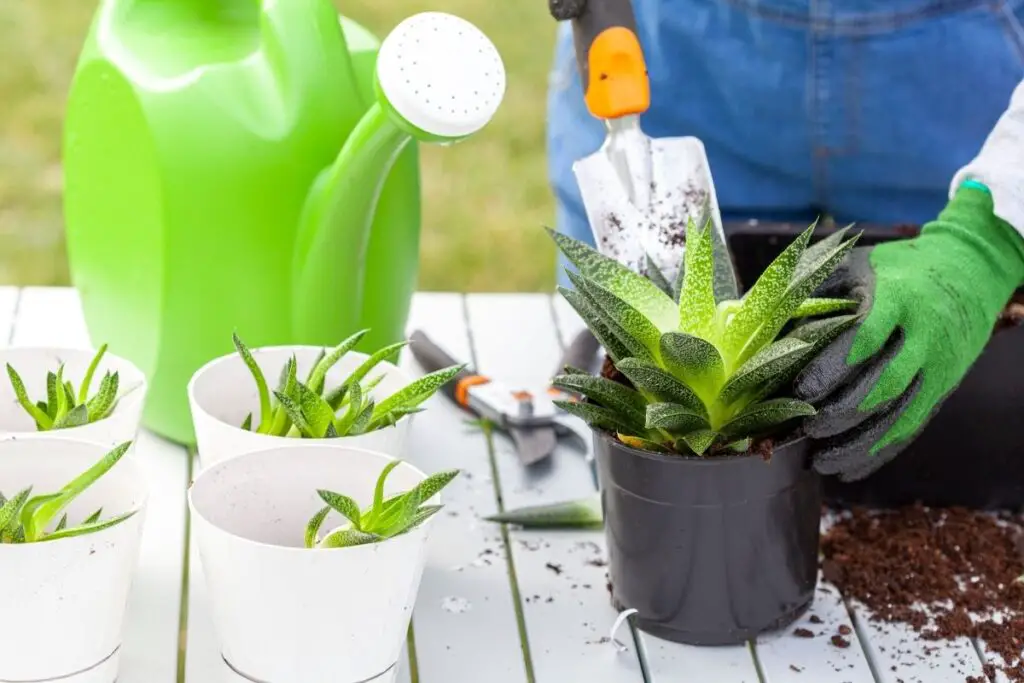
Haworthias are very slow-growing succulents.
That is why they won’t bother you with frequent repotting.
They will take at least a few years to become mature and outgrow their pots.
Once they become mature, along with being rootbound, Haworthias will start producing offsets too.
Repot them every 2-3 years to give them room to spread their roots and produce more offsets.
Additionally, remove the offsets from time to time to avoid overcrowding.
Repotting is mandatory.
If you neglect it just because Haworthias are slow-growers, the plant becomes potbound, and experiences stunted growth, compactness, overwatering, and underwatering.
Ultimately, the plant dies. So, remember to repot them.
Once you do it, you can relax for 2-3 years.
Also read: Do Haworthia Like To Be Root Bound? (+When & How To Repot)
11. Use the right container for Haworthia.
The right type of container for Haworthia depends on the plant’s size and the root mass.
There must be enough space for the roots to grow and spread.
The container must be heavy enough to hold the plant.
An important factor is drainage.
A planter must have drainage holes to drain out excess water.
Otherwise, the roots will begin to rot due to the stagnant water.
Don’t use a big, deep, small or shallow container.
It may cause overwatering, root-bound, or root damage.
A pot must have enough space to let the roots sit, spread, and fill up the pot well.
Select a pot 1-2 inches bigger than the current one for repotting.
To improve drainage, you can use a terracotta pot.
It will wick away moisture quickly and save the plant from overwatering.
There are many other kinds of pots suitable for Haworthia, such as plastic, ceramics, and wooden, and you can try them.
Also read: What Size Pot For Haworthia? (Ideal Material+Size Guide)
12. Taking proper care of Haworthias can result in blooming.
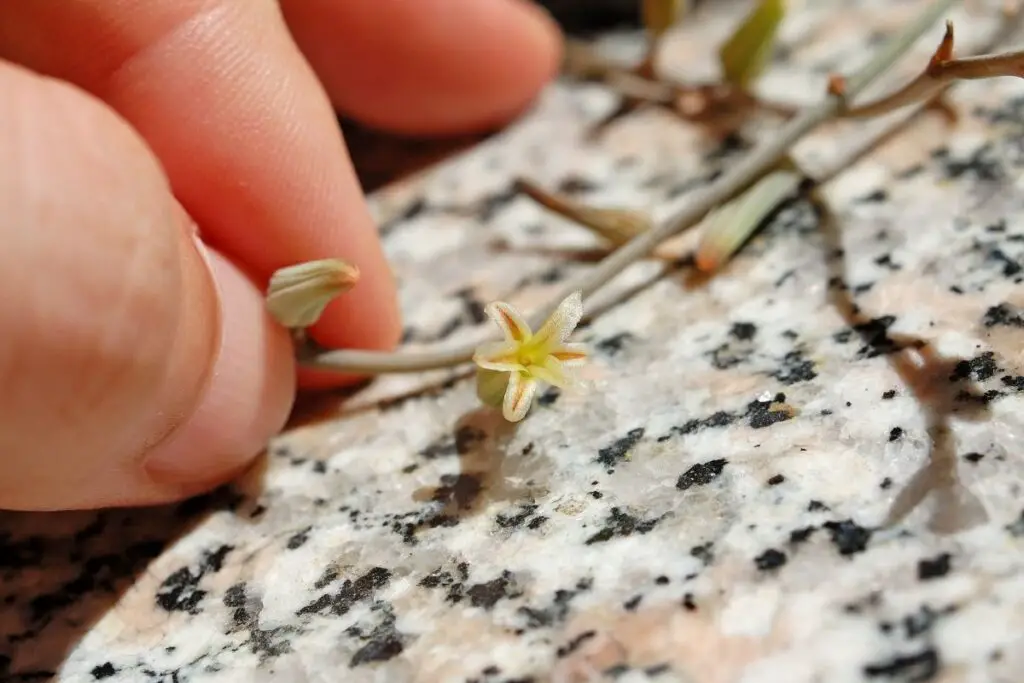
If your plant has been in good health for years, you may see them blooming during the long summer months.
If you are lucky, you will find a flowering stem emerging from the center of the rosette.
After a few months, you will see bud clusters.
This stem can grow around 16 inches.
Haworthias won’t die after flowering, and they can flower multiple times.
If you want the stem to produce a flower, you must take care of it by providing an adequate amount of water and sunlight.
It will help them to hold the stem straight and strong.
After the flower dies, you can cut off the stem.
Also read: Does Haworthia Bloom? (How, When)
13. You can propagate Haworthias to get more plants.
Propagation is an economical way of getting more Haworthias.
If you want to have more of them, you can always do it with leaf cuttings, offsets, and seeds.
For propagating by offsets, just separate the babies and plant them in a new pot.
Choose those that have grown their roots.
They will develop better and mature successfully.
For propagating from leaf cuttings, choose a young and healthy plant from a healthy and mature plant.
It will ensure the successful production of offspring.
If your Haworthia has faced any problem, it is on the verge of death, and there are some healthy leaves left, use them to propagate and get back your plant.
To propagate with seeds, wait for the flower to produce it or buy them online.
It is the most traditional method but not practiced nowadays because it takes a lot of time to develop seedlings.
But, you can try it for the experience.
You can also propagate Haworthias in water by offsets and leaf cuttings.
Take the portion to propagate and place it in a bottle filled with water.
Change the water regularly.
Also read: How To Propagate Haworthia? (3 Ways+A Step-by-Step Guide)
14. Haworthias are non-toxic.
Haworthias have been declared non-toxic by the American Society for the Prevention of Cruelty to Animals.
If ingested, it won’t cause much harm.
But still, it is suggested not to devour.
If ingested too much by mistake, it can result in gastrointestinal and stomach upset.
So, it is better not to consume it.
But keep the plant out of the pets’ and children’s reach.
For outdoor plants, create a barrier or use deterrents like Plantkyyd, Liquid Fence, cayenne powder, mothball, coyote urine, etc.
These products will also prevent pests like rodents, rabbits, horses, and deer.
For indoor plants, keep them somewhere high so that no pets or children can reach them.
It will also ensure that they don’t get hurt by accidental bumping.
Also read: Are Haworthia Plants Poisonous? (Cats, Dogs, Small Animals)
Final words
Haworthias are low-maintenance plants if you become familiar with their care requirements. They don’t require much attention once you get to understand them.
Give Haworthias an adequate amount of light, water, and fertilizer. Let them have proper temperature and humidity and protect them from cold. And don’t bother them much with water and fertilizers in the summer and winter.
Repot Haworthias every 2-3 years and use the right size and type of container. Propagate them to get more plants. Make sure that Haworthias stay away from pets and children.
Reference: The Haworthia Society, Botanical Studies, University of Wisconsin-Madison, Sciencedirect, Researchgate, Haworthia Study.
